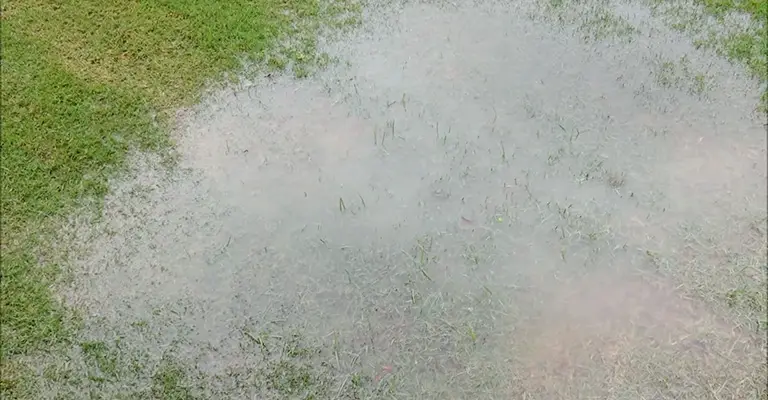Water pooling on a patio can be unsightly and pose potential problems such as damage to the patio surface, slip hazards, and even water seepage into adjacent structures.
Understanding the causes of water pooling and implementing practical solutions can help you maintain a dry and functional patio space.
Preparing for patio drainage problems during slab installation is the best way to prevent water from pooling. The water can also be drained away from the patio by adding a sloping drainage channel.
By addressing this issue promptly, you can enhance the longevity of your patio and improve its overall usability. When it comes to standing water problems on patios, actual rainfalls are just the beginning.
You will likely have to deal with rain if your patio doesn’t drain properly, so you will have to deal with a lot of rainfall for a long time.
An excessive amount of surface water can also cause several problems, including:
- Increasing maintenance (more cleaning, repairs, and antimicrobial treatments)
- Providing a perfect environment for the growth of moss and mildew
- Resulting in possible interior dampness
- Degradation of patio materials
- Icing risks are increased
- A slippery and dangerous surface is created
If your patio turns into a pool when it rains, you will love this guide!
Our goal is to explore several methods for fixing standing water on patio surfaces. That way, you can enjoy your garden again!
Why Is Water Pooling On My Concrete Patio?
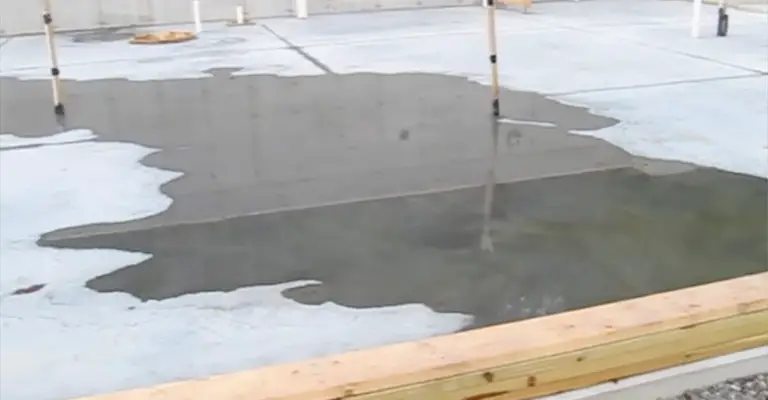
Does your concrete patio or pool deck sit underwater during heavy rains, making outdoor activities impossible?
You can be sure that your patio isn’t draining well when you see this. It is not just bad patio drainage that spoils your outdoor enjoyment but also leads to water seeping into your basement if you have a pool nearby.
In the case of patio drainage issues, the following are the most common causes:
1. Roof Overhangs And Downspouts
A rain overhang or downspout directly flowing onto your patio will cause water to pool quickly in that spot. You can usually resolve the problem by installing a gutter system and redirecting downspouts from the patio.
2. Clogged Drainage System
Your patio drains properly after heavy rain but now seems to accumulate water due to clogged drainage pipes. Eventually, debris can collect in the drainage channels and cause blockages.
3. Improper Slope
It is necessary to angle your patio if it is entirely flat and has low spots where water collects, so water will run off of it, much like a roof gutter slope to direct water to the downspout.
Easy Ways To Fix Standing Water On Patio
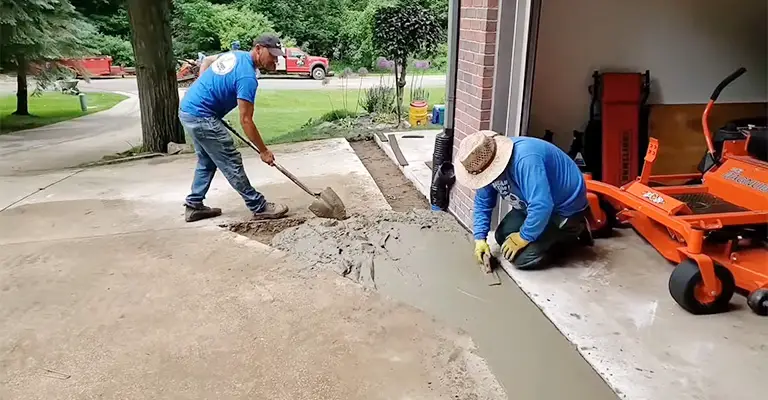
You must maintain your drains properly to prevent water buildup. It is essential to quickly remove any drainage blockages, and you should modify inefficient drains in order to maintain the correct level of drainage.
Usually, patio drainage problems result from the incorrect pitch, the wrong material choice, other water being deposited on the patio, or issues with the drainage system.
It doesn’t matter what the problem is; it needs to be fixed for your patio to remain usable all year long. Several methods exist for dealing with standing water on patio surfaces.
1. Improve the Drainage System
Keeping your drains clean is essential for preventing water buildup. If a drainage blockage occurs, it should be resolved immediately. Inefficient drains should be adjusted to allow the right level of drainage.
2. Redirect Water
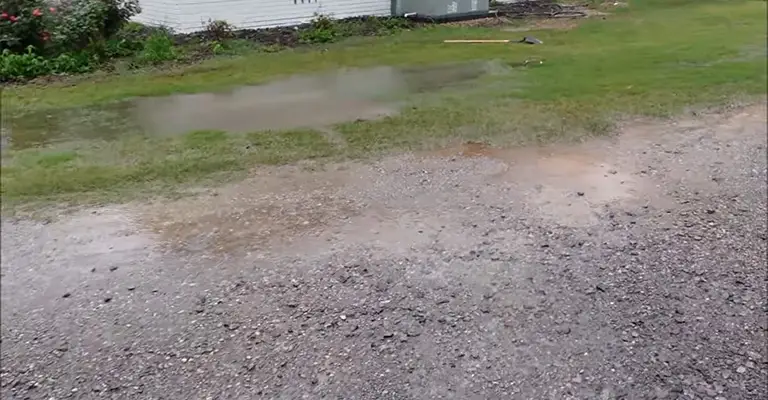
It is essential to redirect water away from your patio if your guttering directs large amounts of water directly into your patio. You can accomplish this by changing the direction of the downspouts.
3. Drill Drainage Holes
It is possible to solve some patio drainage problems by drilling small holes (about 3cm in diameter) in the existing surface and covering them with gravel.
To solve the problem of standing water, the holes will allow some excess water to drain.
4. Overlay the Patio
In the case of serious defects with the pitch of your patio, you may want to consider creating a slope by overlaying it. Having a slightly sloped finish allows water to run off your patio and not collect in puddles.
5. Cut a Drainage Channel
You can also drain the water away from the patio by adding a sloping drainage channel. You can then fill the channel with gravel or a stone of your choice to make it more aesthetically pleasing.
6. Install Channel Drains Or French Drains
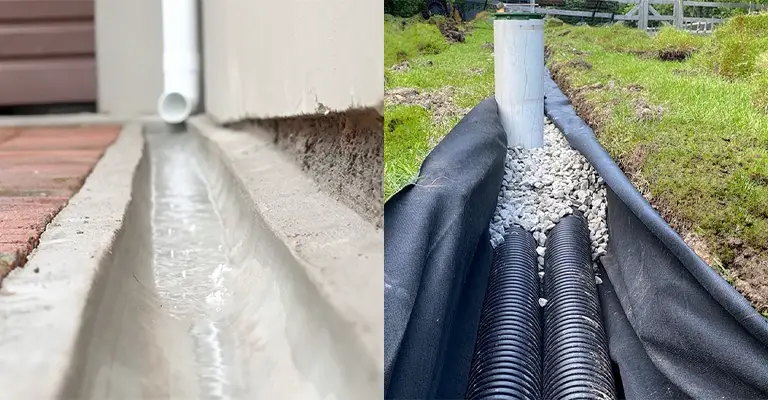
Channel drains and French drains offer adequate drainage on patios. In channel drains, water is collected and diverted away from the patio through a long, narrow trench that is covered by an open grate.
Basically, French drains involve digging a trench and filling it with gravel. A perforated pipe diverts water into the trench.
Plan for Patio Drainage and Install the Right Patio Material
Resin-bound patio surfaces are one solution that will solve your patio drainage problems once and for all.
Rainwater is no match for resin-bound surfaces, which are best equipped to dry quickly without creating a pool on your patio.
Water drains naturally through resin-bound materials, as they are permeable. This resin surface is porous and sustainable drainage system compliant, making it the ideal surface for outdoor applications.
Consequently, resin is an excellent material to use for a variety of purposes, from play parks to driveways to patios and garden paths.
As a result of the resin and aggregate mixture being permeable, along with the beautiful range of styles and colors that are available, resin is genuinely the ultimate patio material.
How Do I Prevent Poor Drainage When Putting In A New Patio?
Installing a slab when drainage problems are anticipated is the best way to avoid them.
A concrete contractor can install an in-slab drainage system filled with gravel channels if the landscape prevents pitching the patio for natural water runoff.
If you want to make the patio more visually appealing, consider dividing it into sections with decorative gravel or groundcovers in between them.
A permeable or porous concrete paver can be used to construct your patio. These pavers allow water to seep through them and reach the ground below.
Your surrounding landscape will also be less eroded and subjected to less stormwater runoff with this solution.
What Are The Solutions For Existing Patios?
Installing a drainage system onto an existing concrete patio is not too late. Create a sloping channel in the concrete to direct water away and fill it with decorative stone or gravel where the water accumulates.
The trench or channel drain made out of metal can be used instead of gravel. Most of these drains are only a few inches wide and contain a mesh to keep debris out while letting water pass through.
As they are flush with the surrounding patio, they won’t constitute tripping hazards. Installing a cement-based overlay over the patio slab is a more radical yet highly effective solution.
This project involved installing an overlay that ranges from 4 inches to under an inch in thickness.
We placed the overlay in sections separated by integrally colored borders, adding decorative interest without cutting into it.
Final Words
It may be beneficial to consult an experienced landscaping contractor, patio contractor, or drainage specialist if you’ve tried several strategies with no success.
Their ability to assess the situation, identify underlying issues, and recommend appropriate solutions is one of their main strengths.

